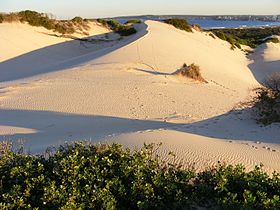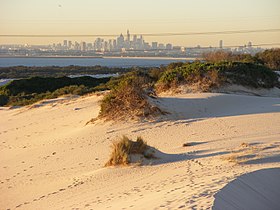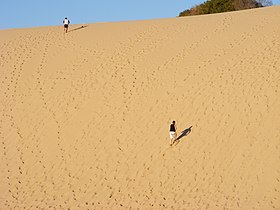This is an old revision of this page, as edited by Adam.J.W.C. (talk | contribs) at 09:40, 15 October 2007 (restoring my edits). The present address (URL) is a permanent link to this revision, which may differ significantly from the current revision.
Revision as of 09:40, 15 October 2007 by Adam.J.W.C. (talk | contribs) (restoring my edits)(diff) ← Previous revision | Latest revision (diff) | Newer revision → (diff)
The Cronulla sand dunes are part of the Wanda Beach coastal landscape, located beside Captain Cook Drive, Cronulla, New South Wales, Australia in the local government area of Sutherland Shire. The Cronulla sand dunes are a protected area that became listed on the NSW State Heritage Register on the 26th of September 2003.
History





The Kurnell Peninsula was the first landing place for Captain James Cook on Australian soil. It was also the site of first contact between the British and the Aborigines in NSW. On 29 April 1770 the HMS Endeavour landed in Botany Bay and Cook stepped ashore. (The area is now marked by a stone memorial (1890) and included within the Botany Bay National Park). Cook’s party stayed in Botany Bay for eight days, gathering botanical specimens, mapping the area and liaising with local Aborigines.
The sand dune system which is also referred to as the Kurnell sand dune is estimated to be about 15,000 years old. It was formed when the sea reached its present level. The geology and geomorphology of the area is characterised by an island of outcropping bedrock on the eastern headland and joined to other bedrock outcrops on its western end by a sand spit which forms the main part of the headleand. The Peninsula still has quite a view overlapping transgressive barrier dunes and it is believed that they have shifted north from Bate Bay. Older stable parabolic dunes occur on a series of north to south oriented ridges and while most of the vegetation has been cleared, some dry schlerophyll woodland remains.
Approximatly one million years ago the Kurnell peninsula was an island. The Georges, Cooks and Towra Rivers flowed to the south-east and joined the ocean at Bate Bay. This resulted in the isolation of Kurnell from the mainland. Sediment built up within the channels and coerced the rivers into changing their course. The deepest part of the ancient river channel now lies 100 meters below the surface at the southern end of the peninsula. Towra Point is actually a delta formation of relict mud and sand between the ancient rivers.
In more recent times, the site has been used as a back drop for several Australian movies such as the epic 40,000 Horsemen (1941), The Rats of Tobruk and more recently Mad Max 3.
In January 1965 the bodies of two 15-year-old girls were found in the sand hills just off Wanda Beach. They had been bashed, stabbed and sexually assaulted. The murderer has not yet been identified and the case remains one of Australia’s most notorious, unsolved crimes, known as the 'Wanda Beach Murders'. .
European Settlement
The landscape of the sand dune system bears little resemblance to that experienced by the local Aboriginal people and first seen by Captain Cook. In 1770 shortly after his arrival, James Cook looked down from the sand hills at what is now known as Cronulla Beach. The sand dunes were completely covered in vegetation, so Cook made no mention of any sand dunes during his visit to the Kurnell peninsula. Less than 100 years later, nearly all of the original vegetation had been cleared and burnt, larger trees had been ring barked or simply cut down due to the high demand for timber and grazing. The land on this peninsula was not suited for intensive grazing, so after most of the trees were felled, herds of cattle then removed the stabilizing grass cover and exposed the sand dunes underneath. Large expanses of sand had been exposed along the coastline. The dune system that covers and area of 1000 acres, measuring 40 meters above and 90 meters below sea level, became unstable and began to move north at a rate of 8 meters a year. The environmental impact of land clearing and cattle grazing resulted in a degraded landscape but they created what has become the distinctive Cronulla sand dunes of today.
Between 1920 and 1930 the sand hills were acknowledged to be a deserted and desecrated landscape and their economic value was minimal. However, by the 1920s Cronulla had become notable for its beaches with over five kilometers of sand stretched along the coastline. The bare sand dunes became synonymous with Cronulla. Between the 1920s and the 1950s the large expanses of sand became a popular playground for generations of children for activities such as sandboarding.
Sand mining
In 1933 the Sutherland Shire Council asked the Government to set aside the 2000 acres between Cronulla Golf Club and Kurnell as a reserve. In April 1937, Haymarket Land and Building Co. offered Sutherland Shire Council 720 acres of land near the entrance to Kurnell for 8 pounds per acre. Most of the councillors wanted to declare the site a National Park. They wanted it to be titled "the Birthplace of Australian History and Gateway to Captain Cook's Landing Place". The dunes at Towra Point were to be included in this park. The Council was evenly split, but Joe Monro, the Council's President , argued that because the site "was nothing but sand it was completely useless". He decided to vote against the purchase. The sandhills were doomed from that point. The Government couldn't see any reason to establish another National Reserve so near to Captain Cook's Landing Place Reserve.
In the 1930s the Holt family began its sand mining operations to supply the expanding Sydney building market and continued until 1990 with an estimate of over 70 million tonnes of sand having been removed. The sand has been valued for many decades by the building industry, mainly because of its high crushed shell content and lack of organic matter and has provided a cheap source of sand for most of Sydney since sand mining operations began. The site has now been reduced to a few remnant dunes and deep water-filled pits which are now being filled with demolition waste from Sydney's building sites. Removal of the sand has significantly weakened the peninsula's capacity to resist storms. Ocean waves pounding against the reduced Kurnell dune system have threatened to break through to Botany Bay, especially during the storms of May and June back in 1974 and of August 1998.
Caltex oil refinery
In 1951 Caltex Oil Company approached Sutherland Shire Council for the first time with a proposal to build an oil refinery at Kurnell. It required a large block of land of approximatly 400 acres in size. At first the Council rejected this proposal. The matter sparked a number of protests from environmental groups and those concerned that the refinery would mar Captain Cook's Landing Place Reserve. Not long after the proposal, Sutherland Shire Council withdrew its objection, and what became known as the Australian Oil Refinery Company, a subsidiary of Caltex, began operating in 1954. Whilst the refinery was being built, the Council also built Captain Cook Drive to allow access to the refinery.
Further development

Industrialisation of the Kurnell Peninsula continues to be an ongoing problem amongst community groups and environmentalists. Plans for further development at the site has been cause for continual public protest between developers, locals and environmental groups. A proposal to build a chemical plant by the German pharmaceutical company, Bayer back in 1986 resulted in public protests, environmental objections and a Commission of Inquiry. The plan never went ahead on the grounds of both environmental and economic issues.
In 2004 a major industrial development at the Kurnell site just north of Wanda Beach has been given the go ahead by the Land and Environment Court. This has Prompted fears that the State Government will now approve the construction of hundreds of homes to be built on the site. The court upheld an appeal by Australand, allowing it build on one-third of the 62-hectare site, "subject to conditions such as safeguarding the environment".
Sutherland Shire Council had objected to the proposal, citing issues such as the impact on the threatened green and golden bell frog. The council also put forth their concerns about the ecosystem, the two key areas in question were the sandhills and the freshwater wetland area. The court's commissioners rejected the Sutherland Shire's case, ruling in favour of the Austaland development. The court also accepted that the Wanda sand hills had to be re vegetated to to stop the sand from filling up ponds and swallowing up the vegetation in the area. The council has spent $650,000 on the case and wants the area set aside for tourism, environmental conservation and heritage.
In 2000 a proposal by Australand for 250 houses on the same site was called in by the then minister for planning, Andrew Refshauge.The Opposition said the land court's decision could encourage the Government to allow for the construction of a large housing development on the site.
Aboriginal Culture
The original inhabitants on the Kurnell Peninsula were the Dharawal people an Aboriginal tribe that has occupied the region for thousands of years. They made first contact with James Cook and other Europeans and occupied the area which is now reserve (Captain Cooks Landing Place). Today members of the Dharawal nation still live near the park and participate in their traditional Aboriginal art and culture.
The site also has historical and cultural significance to the original inhabitants. The landscape possesses historical, cultural, scientific and natural significance as a place of early European contact with Aborigines. The area has significant Aboriginal signs of habitation, from carvings, ceremonial sites, middens and sites of flaked sharpening stones. The site has significant interest to the Aboriginal community as many of the other hills and dunes that were inhabited by their ancestors have now been removed. As the dunes move or drift over time, many of the sites once occupied by the Aboriginal people have been covered over and preserved.
Fitness training

Amateur and professional athletes on a daily basis push themselves to exhaustion in unforgiving soft-sand conditioning sessions at the Cronulla sandhills. This is to either keep fit, stay in shape or prepare for amateur and, or professional sporting events, events like Rugby league, Rugby union, Cricket, Soccer and boxing.
At one stage professional cricketers Glenn McGrath, Michael Clarke, Ricky Ponting, Brett Lee and Brad Haddin trained at the sand dunes on daily basis in preparation for international test cricket. Anthony Mundine held a one-hour workout in the sandhills to prepare for his bout with WBA super-middleweight champion Mikkel Kessler.
Amateur and professional Rugby league teams, especially those of the NRL also use the sandhills.
At inclines of 45 degrees or more, these sandhills rise upwards and all but collapse downwards in hour-long sprint sessions. According to the conditioning coach of the Australian Cricket team Jock Campbell, these sandhills, along with gym programs is the best way to train athletes for endurance work. "Working in the sandhills is hard aerobic interval training, and good specific leg training without the shock on knees and ankles.
Gallery
Google map
Google map and satellite image of the Cronulla Sand Hills
References
- http://www.heritage.nsw.gov.au/07_subnav_02_2.cfm?itemid=5051207
- http://www.ssec.org.au/our_environment/our_bioregion/kurnell/history/origins/index.htm
- http://www.ssec.org.au/our_environment/our_bioregion/kurnell/history/occupation/sandhills.htm
- http://www.heritage.nsw.gov.au/07_subnav_02_2.cfm?itemid=5051207
- http://www.aussieheritage.com.au/listings/nsw/Kurnell/KurnellSandDune/5414
- http://commons.wikimedia.org/Image:2007_0806klklk0001.JPG
- http://www.ssec.org.au/our_environment/our_bioregion/kurnell/history/industries/sandmining.htm
- http://www.ssec.org.au/our_environment/our_bioregion/kurnell/environment/dunes.htm
- http://www.smh.com.au/articles/2004/01/26/1075087962858.html
- http://www.trinswrace.org/default.asp?PageID=1267
- http://www.foxsports.com.au/story/0,8659,15337495-23212,00.html
- http://forums.muslimvillage.net/lofiversion/index.php/t11676.html
- http://www.stgeorgerugby.com/modules.php?op=modload&name=PagEd&file=index&page_id=54
- http://search.yahoo.com/search;_ylt=A0oGkmiIZ7xGVy4BAkZXNyoA?p=Rugby+legue+training+at+wanda+sandhills&y=Search&fr=yfp-t-486
- http://www.teda.id.au/fitness/cronulla-kurnell-sand-dunes
| Beaches of New South Wales | |
|---|---|
| Sydney |
|
| South Coast | |
| North Coast | |


